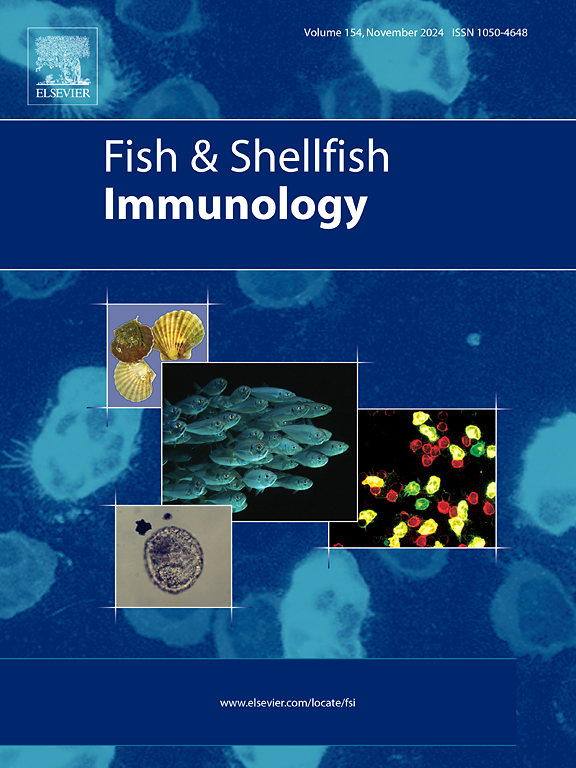赤链球菌易感罗非鱼和耐受罗非鱼 T 细胞免疫力的比较分析
IF 4.1
2区 农林科学
Q1 FISHERIES
引用次数: 0
摘要
尼罗罗非鱼(Oreochromis niloticus)是全球养殖的重要经济鱼类之一。然而,无乳链球菌已成为一种重要的细菌威胁,严重影响了罗非鱼产业的经济效益。罗非鱼对 S. agalactiae 产生抗性的免疫反应尚不十分清楚,这阻碍了对育种的合理评估和有效策略的制定。在这项研究中,我们调查了抗赤潮镰刀菌罗非鱼和易感罗非鱼的 T 细胞免疫差异。与易感罗非鱼相比,抗性罗非鱼在感染期间表现出更高比例的 T 细胞和 BrdU+ T 细胞,表明其具有更强的增殖能力。无论是否感染,抗性罗非鱼的 T 细胞都表现出更强的抗凋亡能力。此外,抗性罗非鱼的 T 细胞效应基因,包括白细胞介素 (IL)-2、干扰素 (IFN)-γ、穿孔素 A 和颗粒酶 B 在感染后的表达水平更高。伴随着这些 T 细胞免疫反应,抗性罗非鱼表现出更有效的感染清除能力。我们的研究阐明了抗性罗非鱼的T细胞免疫反应,这可能是罗非鱼对S. agalactiae具有高度抗性的原因之一,并为今后抗病鱼种的选择和评价提供了有价值的理论参考。本文章由计算机程序翻译,如有差异,请以英文原文为准。
Comparative analysis of T-cell immunity between Streptococcus agalactiae susceptible and resistant tilapia (Oreochromis niloticus)
Nile tilapia (Oreochromis niloticus) is one of the important economic fish species cultured worldwide. However, Streptococcus agalactiae has emerged as a significant bacterial threat, severely impacting the economy of tilapia industry. The immune response underlying the resistance of tilapia to S. agalactiae are not well understood, hindering the reasonable evaluation of breeding and the formulation of effective strategies. In this study, we investigated the differences in T-cell immunity between S. agalactiae-resistant and -susceptible tilapia. Compared with susceptible tilapia, resistant tilapia exhibited a higher percentage of T cells and BrdU+ T cells during infection, indicating a superior proliferative capacity. Whether infected or not, T cells from resistant fish demonstrated a greater ability to resist apoptosis. Additionally, T cell effector genes, including interleukin (IL)-2, interferon (IFN)-γ, perforin A, and granzyme B were expressed at higher levels in resistant tilapia after infection. Along with these T-cell immune responses, resistant fish showed more effective clearance of infection. Our study elucidates the T-cell immune responses in resistant tilapia, which may contribute to the high resistance of tilapia to S. agalactiae, and provide valuable theoretical references for the selection and evaluation of disease-resistant fish strains in the future.
求助全文
通过发布文献求助,成功后即可免费获取论文全文。
去求助
来源期刊

Fish & shellfish immunology
农林科学-海洋与淡水生物学
CiteScore
7.50
自引率
19.10%
发文量
750
审稿时长
68 days
期刊介绍:
Fish and Shellfish Immunology rapidly publishes high-quality, peer-refereed contributions in the expanding fields of fish and shellfish immunology. It presents studies on the basic mechanisms of both the specific and non-specific defense systems, the cells, tissues, and humoral factors involved, their dependence on environmental and intrinsic factors, response to pathogens, response to vaccination, and applied studies on the development of specific vaccines for use in the aquaculture industry.
 求助内容:
求助内容: 应助结果提醒方式:
应助结果提醒方式:


